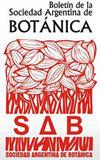Modificaciones histológicas foliares causadas por organismos fúngicos en tres especies de Myrtaceae.
IF 0.7
4区 生物学
Q4 PLANT SCIENCES
Boletin De La Sociedad Argentina De Botanica
Pub Date : 2017-09-29
DOI:10.31055/1851.2372.V52.N3.18026
引用次数: 1
Abstract
Histological changes in leaves caused by fungi in three species of Myrtaceae. The family Myrtaceae is one of the largest in Argentina. In the province of Tucuman, eleven native species inhabit, three of them, Blepharocalyx salicifolius (Kunth) O. Berg, Eugenia uniflora L. and Myrcianthes pungens (O. Berg) D. Legrand have medicinal, alimentary and forestry importance. Information about fungal species and histological foliar changes produced by them is limited. So the objective of this research is to identify the species of fungi present in leaves of these three tree species; and evaluate the anatomical changes caused by the presence of them. Conventional techniques and stains were used. Twelve fungal species were identified in the three arboreal hosts studied. Ten species were cited for the first time for Argentina. Puccinia psidii and Alternaria sp. were found more frequently. The most affected leaf tissues were the palisade and spongy parenchyma. The most significant lesion was that one observed in the leaf of E. uniflora, it was produced by Microsphaerospis arundinis. Fungal identified species increases the knowledge of the diversity of fungi associated with leaves in native tree species from province of Tucuman.真菌对三种桃金娘科植物叶片组织学的影响。桃金娘科是阿根廷最大的科之一。图库曼省有11种本地植物,其中Blepharocalyx salicifolius (Kunth) O. Berg、Eugenia uniflora L.和Myrcianthes pungens (O. Berg) D. Legrand 3种具有重要的药用、食用和林业价值。关于真菌种类和它们引起的组织学叶面变化的信息是有限的。因此,这项研究的目的是确定这三种树种叶子中存在的真菌种类;并评估它们的存在所造成的解剖变化。使用常规技术和染色。在3种树栖寄主中鉴定出12种真菌。阿根廷有10种首次被引用。psidii和Alternaria sp.较常见。受影响最大的是叶栅和海绵薄壁组织。单花叶中最显著的病变是由微球孢子虫(microsphaspis arundinis)引起的。真菌鉴定物种增加了对图库曼省本地树种叶片相关真菌多样性的认识。
本文章由计算机程序翻译,如有差异,请以英文原文为准。
求助全文
约1分钟内获得全文
求助全文
来源期刊

Boletin De La Sociedad Argentina De Botanica
PLANT SCIENCES-
CiteScore
1.00
自引率
33.30%
发文量
46
审稿时长
>12 weeks
期刊介绍:
Bol. Soc. Argent. Bot. publishes original scientific works from the whole spectrum of Plant Biology (structure, anatomy, development, physiology, cytology, genetics, evolution, ecology, paleobotany, palynology, ethnobotany, etc.) in the diverse vegetable organisms and related groups (mycology, ficology, lichenology, briology, etc.), both in basic and applied aspects.
Taxonomic works (of systematics, phylogeny, monographs, revisions, lectotypifications, nomenclatural acts, descriptions of taxa), phytogeographic and phytosociological works (survey and classification of vegetation at different spatial scales and without restriction of methodological approaches) are considered for publication. Contributions that address complete phytogeographic units or sub-units and those that fill gaps in knowledge of vegetation in little-known territories are especially welcome. Extensions of geographical areas are published only when it comes to new citations for a country. Checklists and lists of annotated plants are not published.
Articles submitted for publication must be original and must not have been submitted to another publisher or previously published (print or electronic format). Submissions of papers already published in another language will not be accepted (autoplagio for translation).
 求助内容:
求助内容: 应助结果提醒方式:
应助结果提醒方式:


